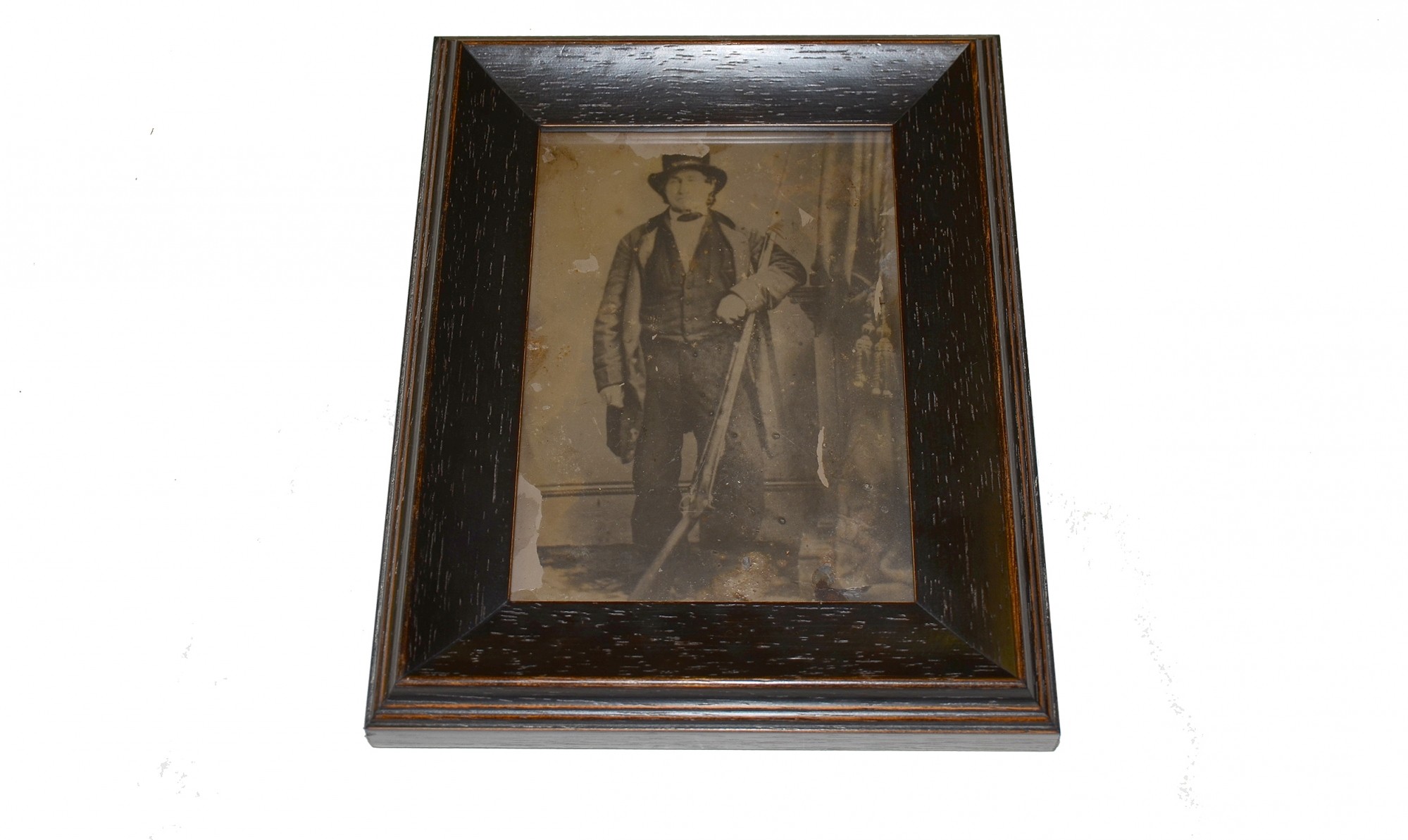site search
online catalog
HALF PLATE TINTYPE OF JOHN BURNS, CIVILIAN HERO OF GETTYSBURG

$975.00 SOLD
Quantity Available: None
Item Code: 573-14
This is a full standing view of John Burns. He is wearing a light colored frock coat, dark colored trousers, white shirt, cravat and hat. A rifle rests in the crook of his arm. Image is clear with good contrast. Some oxidation has occurred.
Tintype is in a dark brown wooden frame which is in excellent condition. Frame measures 7 ½” x 9 ½”.
John Lawrence Burns (September 5, 1793 – February 4, 1872), veteran of the War of 1812, became a 69-year-old civilian combatant with the Union Army at the Battle of Gettysburg during the American Civil War. He was wounded, but survived to become a national celebrity.
He served as an enlisted man in the War of 1812, fighting in numerous battles, including Lundy's Lane, and volunteered for both the Mexican-American War and the Civil War. He was rejected for combat duty in the latter war due to his advanced age, but he served as a teamster in support of the Union Army. He was sent home against his will to Gettysburg, Pennsylvania, where he was named constable. During Confederate Maj. Gen. Jubal A. Early's brief occupation of Gettysburg on June 26, 1863, Burns was jailed for his adamant assertion of civil authority in resisting Early. As the Confederates departed, Burns was released from jail and arrested some of the Confederate stragglers, continuing his opposition to the invading army until he was relieved by Federal cavalry under Brig. Gen. John Buford.
On the first day of the Battle of Gettysburg, July 1, 1863, Burns took up his flintlock musket and powder horn and walked out to the scene of the fighting that morning. He encountered a wounded Union soldier and asked if he could use his more modern rifle; the soldier agreed and Burns moved on with the rifle and with cartridges in his pocket. Approaching Major Thomas Chamberlin of the 150th Pennsylvania Infantry, Burns requested that he be allowed to fall in with the regiment. Chamberlin later wrote of Burns moving with deliberate step, carrying his Enfield rifle at a trail. His somewhat peculiar dress "consisted of dark trousers and a waistcoat, a blue 'swallow tail' coat with burnished brass buttons, such as used to be affected by well-to-do gentlemen of the old school about 40 years ago, and a high black silk hat, from which most of the original gloss had long departed, of a shape to be found only in the fashion plates of the remote past." Despite his skepticism about the request, Chamberlin referred him to the regimental commander, Colonel Langhorne Wister, who sent the aged Burns into the woods next to the McPherson Farm, where he would find better shelter from the sun and enemy bullets.
In McPherson (Herbst) Woods, Burns fought with the 7th Wisconsin Infantry and then moved to join the 24th Michigan near the eastern end of the woods. He fought beside these men of the famous Iron Brigade throughout the afternoon, serving effectively as a sharpshooter, in one case shooting a charging Confederate officer from his horse. As the Union line began to give way and they fell back to the Seminary, Burns received wounds in the arm, the leg, and several minor ones in the breast; the Union soldiers were forced to leave him behind on the field. Injured and exhausted, the old man was able to crawl away from his rifle and to hastily bury his ammunition. He convinced the Confederates that he was a noncombatant, wandering the battlefield seeking aid for his invalid wife, and his wounds were dressed by their surgeons. This was a narrow escape for Burns, for by the rules of war he was subject to summary execution as a non-uniformed combatant, or bushwhacker. He was able to crawl that evening to the cellar of the nearest house, and was later conveyed to his own home, where he was treated by Dr. Charles Horner
After the battle, Burns was elevated to the role of national hero. Hearing about the aged veteran, Mathew Brady's photographer Timothy H. O'Sullivan photographed Burns while recuperating at his home on Chambersburg Street and took the story of Burns and his participation in the battle back home to Washington. When President Abraham Lincoln came to Gettysburg to dedicate the Soldiers National Cemetery and deliver his Gettysburg Address that fall, he requested to meet with Burns. Burns accompanied the president on a walk from the David Wills house to the Presbyterian Church on Baltimore Street on November 19, 1863.
Burns is buried in Evergreen Cemetery in Gettysburg. His is one of only two graves there with permission to fly the American flag twenty-four hours per day (the other being the grave of Jennie Wade, the only civilian killed during the battle). It bears the inscription "Patriot"
There is a monument to him on Stone Avenue on the Gettysburg Battlefield which was dedicated on July 1, 1903. [sm]
~~~~~~~~~~~~~~~~~~~~~~~~~~~~~~~~~~~
THIS ITEM, AS WITH ALL OTHER ITEMS AVAILABLE ON OUR WEB SITE,
MAY BE PURCHASED THROUGH OUR LAYAWAY PROGRAM.
FOR OUR POLICIES AND TERMS,
CLICK ON ‘CONTACT US’ AT THE TOP OF ANY PAGE ON THE SITE,
THEN ON ‘LAYAWAY POLICY’.
THANK YOU!
Inquire About HALF PLATE TINTYPE OF JOHN BURNS, CIVILIAN HERO OF GETTYSBURG
For inquiries, please email us at [email protected]
Most Popular
Historical Firearms Stolen From The National Civil War Museum In Harrisburg, Pa »
Theft From Gravesite Of Gen. John Reynolds »
Cavalry Carbine Sling Swivel »
Fine Condition Brass Infantry Bugle Insignia »
featured item
HANDSOME INSCRIBED MOORE REVOLVER WITH HOLSTER OF C.H. RICHMOND
Moore revolvers used the .32 caliber self-contained metallic rimfire cartridge, which was available and convenient. They were not subject to damage by rough handling, weather resistant, and made a pistol fast to load. Moore also provided value for… (2023-2603). Learn More »




